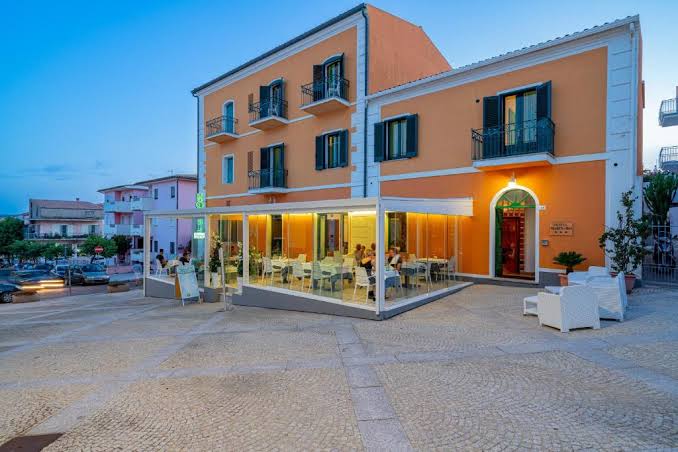Hotel Marinaro: The Hidden Pearl of the Amalfi Coast
Title: “Hotel Marinaro: The Hidden Pearl of the Amalfi Coast”
By Elena Moretti, Travel Features Editor
High above the cerulean embrace of the Tyrrhenian Sea, carved into the sun-kissed cliffs of Italy’s Amalfi Coast, lies a secret that refuses to stay quiet. It’s whispered about in boutique cafés in Rome, murmured among seasoned travelers in Positano, and passed like a sacred code among those who still believe in magic—Hotel Marinaro.
A hotel in name, a legend in essence, Marinaro is not found by chance. There are no billboards, no social media accounts, and certainly no package deals. You find it if you’re meant to. And once you do, you never forget it.
Chapter 1: A Legacy Etched in Stone
Hotel Marinaro was built in 1893 by Count Lorenzo Marinaro, an aristocrat with a penchant for art, astronomy, and solitude. Legend has it that he designed the hotel after falling in love with a fisherman’s daughter named Livia. She had a voice like sea glass and dreams of building a home where land and sea could whisper to each other without interruption. The hotel, perched on the cliffs near the fictional village of Sant’Emeria, was their love letter to the coast.
Constructed from volcanic rock and sun-bleached sandstone, the original structure featured only eight rooms, each hand-painted with frescoes depicting constellations, sea creatures, and scenes from Livia’s favorite operas. Every doorframe was carved by hand; every window perfectly aligned with the setting sun during the spring equinox.
But the Marinaro legacy isn’t just artistic—it’s ghostly. Locals claim the hotel is protected by the spirit of Livia herself, who died tragically young from a fever. Guests still report hearing soft lullabies in the middle of the night, sung in Neapolitan dialect, echoing through the stone hallways.
Chapter 2: A Revival in the Modern Age
For most of the 20th century, Hotel Marinaro was closed to the public, inherited by a series of distant relatives and left to decay like a forgotten stanza in a poem. Then, in 2007, it was purchased and lovingly restored by Isabella Danti, a Milanese architect with roots in the south.
“I didn’t buy a hotel,” Isabella tells me over a glass of limoncello in the hotel’s open-air courtyard, where vines curl lazily over wrought-iron balconies. “I bought a story. I was just lucky enough to be chosen to tell the next chapter.”
Isabella’s restoration was meticulous. Rather than strip the building of its character, she preserved its flaws—cracked frescoes, uneven stone stairways, a sundial that runs five minutes slow. She added just enough modernity to make the stay comfortable: discreet air conditioning, geothermal heating, and a saltwater infinity pool that seems to pour directly into the ocean below.
Now the hotel boasts 14 rooms, each still bearing a name rather than a number: The Siren’s Alcove, The Cartographer’s Refuge, Orione, and Livia’s Room, which is always booked a year in advance.
Chapter 3: The Guests Who Vanish (and Return)
Marinaro doesn’t attract crowds. It seduces solo travelers, writers, astronomers, grieving widows, and jaded tech billionaires trying to remember what silence sounds like.
No one stays here without being changed.
Take Chiara Vivaldi, a concert pianist who arrived on a whim in 2016 after canceling a world tour. “I stayed for three weeks and never touched a piano,” she says. “I watched the light move across the tiles in my room. I swam at night. I listened to wind. And when I returned to Milan, I played better than I ever had. Not because I practiced—because I remembered.”
There are dozens of such stories. A Parisian chocolatier who rewrote his life’s mission after tasting a lemon tart made with wild citrus from the cliffs. A software developer from Tokyo who now paints underwater landscapes in oils. A couple from Vermont who never returned to their lives in the States—they now run the hotel’s garden.
Hotel Marinaro has no televisions, no spa, no in-room phones. What it offers instead is something far more difficult to find: time unstructured, unhurried, untouched.
Chapter 4: Cuisine as Alchemy
If the rooms are poetry, the food at Hotel Marinaro is spellwork.
Chef Enzo Marino—who trained in Lyon but claims his best lessons came from his grandmother in Napoli—doesn’t serve meals so much as create edible sonnets. Breakfast is a fluid affair: figs with goat cheese and rosemary honey, paper-thin pastries filled with pistachio cream, wild strawberries arranged with geometric care.
Lunch, when served, is often a single dish: maybe ricotta-stuffed zucchini blossoms or saffron risotto with squid ink. Dinner is a five-course tasting menu that changes with the tides—literally. Fish is caught in the morning; herbs are clipped from a wind-swept garden above the kitchen; salt is gathered from natural sea pans below the cliff.
“I don’t use recipes,” Enzo shrugs when asked for his method. “The coast tells me what it wants. I just listen.”
Chapter 5: The View That Breathes With You
Step onto the terrace of Room Orione at sunset and something peculiar happens: your breath slows. The horizon isn’t just a line here—it’s a living gradient of gold, pink, and lavender. Seagulls trace their own constellations across it. The sound of the sea is omnipresent but never demanding, like a lullaby you heard as a child and forgot until now.
At night, the stars here don’t twinkle—they blaze. Guests are offered a glass of local Falanghina and an antique brass telescope that belonged to Count Marinaro himself. A small observatory on the roof is maintained by Paolo, the hotel’s night caretaker and amateur astronomer, who offers stargazing sessions with historical anecdotes that feel more like bedtime stories.
“I think the sky is different here,” he says one evening. “Not brighter. Just more honest.”
Chapter 6: Departure Is a Kind of Death
Leaving Hotel Marinaro is not easy. There are no taxis in Sant’Emeria. Guests walk a narrow cobblestone path to the village’s only bus stop, where a single coach leaves at dawn and dusk. Often, guests delay departure. Some miss the bus entirely. The staff seems unsurprised.
“You leave when it’s time,” Isabella says, pouring more coffee as the morning sun climbs over the lemon trees. “Some people just know when that is.”
The hotel’s unofficial motto, written discreetly above the library door, reads: “Chi trova Marinaro, trova sé stesso.”
“Who finds Marinaro, finds themselves.”
Epilogue: Letters From the Edge
Every December, the hotel receives hundreds of handwritten letters—some addressed to no one, some to Livia, others simply marked “Marinaro.” These letters are never opened. Instead, they are placed in a cedar box in the hotel’s library and burned in a ceremony on New Year’s Eve.
“It’s not about reading them,” Isabella explains. “It’s about letting them go.”
And maybe that’s what Marinaro offers more than anything—a place where you can let go. Of burdens. Of noise. Of who you thought you had to be.
As I board the bus back to the modern world, the wind carries a scent of orange blossom and salt. Somewhere in the distance, a woman is singing.
I don’t speak enough Neapolitan to understand the words, but I know what they mean.
Hotel Marinaro at a Glance:
- Location: Sant’Emeria (fictitious), Amalfi Coast, Italy
- Rooms: 14 unique rooms, no two alike
- Rates: Upon inquiry only; expect €600–€1,200 per night
- Best Time to Visit: Late April to early June, or mid-September
- No Children, Pets, or Tour Groups
- How to Book: Email inquiries only; applicants are selected individually
- Website: Not available
- Wi-Fi: Yes, but why would you?







